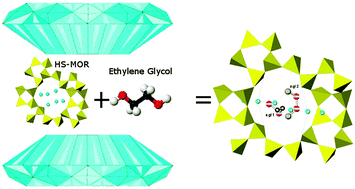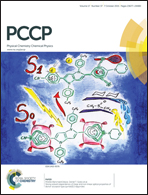Pressure-induced penetration of guest molecules in high-silica zeolites: the case of mordenite†
Abstract
A synthetic high-silica mordenite (HS-MOR) has been compressed in both non-penetrating (silicone oil, s.o.) and penetrating [methanol : ethanol : water (16 : 3 : 1) (m.e.w.), water : ethanol (3 : 1) (w.e.), and ethylene glycol (e.gl.)] pressure transmitting media (PTM). In situ high-pressure (HP) synchrotron X-ray powder diffraction (XRPD) experiments allowed the unit cell parameters to be followed up to 1.6, 1.8, 8.4, and 6.7 GPa in s.o., w.e., m.e.w., and e.gl., respectively. Moreover, e.gl. was also used as a PTM in in situ HP Raman and ex situ IR experiments. The structural refinement of HS-MOR compressed in e.gl. at 0.1 GPa – the lowest investigated pressure – revealed the presence of 3.5 ethylene glycol molecules per unit cell. The infrared spectrum of the recovered sample, after compression to 1 GPa, is consistent with the insertion of ethylene glycol molecules in the pores. XRPD and Raman spectroscopy experiments performed under pressure indicated the insertion of a small number of guest molecules. Ethylene glycol is partially retained inside mordenite upon pressure release. A symmetry lowering was observed in s.o. above 0.8 GPa, while above 1.6 GPa the patterns indicated a rapid loss of long range order. From ambient pressure (Pamb) to 1.6 GPa, a high cell volume contraction (ΔV = −9.5%) was determined. The patterns collected with penetrating PTM suggested the penetration of guest molecules into the porous host matrix, starting from a very low P regime. The entrapment of PTM molecules inside micropores contributes to the stiffening of the structure and, as a consequence, to the decrease of the compressibility with respect to that measured in s.o. From the structural point of view, HS-MOR reacts to compression and to the penetration of different guest species with appropriate framework deformations. Interestingly, ethylene glycol is partially retained inside mordenite upon pressure release, which is of importance for potential application of this composite material.



 Please wait while we load your content...
Please wait while we load your content...